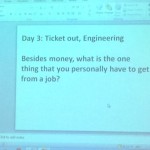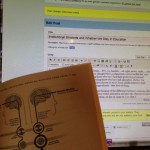“If you love kids you belong in an elementary school. If you love content, you belong in a high school. And if you love a challenge, then middle school is for you.” This is a piece of advice I received years ago from an old colleague.
While I fully agree that middle school is a challenge, I’ve come to see the danger of buying into the stereotype that elementary teachers don’t have passion for content and high school teachers don’t really need to care about kids. Like all stereotypes, it’s incomplete at best. But for a long time I accepted it as true. As a result, in my first years as a teacher, I struggled to find the place I felt I truly belonged. My teacher certification is Elementary Education 1-8 and Special Education K-12. So, I had a range of potential teaching opportunities to choose from when I started my career. As I navigated my first three years as a teacher, I was faced with choices about which direction I wanted my career to go. I wanted to make a difference and I wanted to find joy. So I took stock of what I knew I loved:
Love Number 1: Kids! I found them funny and charming. I loved being able to spark that “lightbulb moment.”
Love Number 2: Learning about the brain. I was fascinated by pedagogy. Learning about learning is honestly so cool.
Love Number 3: Literature (especially historical fiction).
Love Number 4: Learning about human connections—how we interact in society, how we influence one another, how our perspectives shape our choices, and how shared experience can be a conduit for human connection.
Given these things I knew about myself, I figured I would be very happy in an elementary school special education setting. When I found I wasn’t as happy as I expected to be, I knew I needed a change. I found an opportunity to teach at a high school as a co-teacher in English and Social Studies. How cool was this? I could combine all four of my passions and really have an impact on kids. It was in this setting that I developed a deeper interest and passion for history, geography, and government. I became highly qualified in social studies. I taught and co-taught world history and U.S. history. I also became a National Board Certified Teacher in the area of Social Studies-History. My passion for content was really growing and I thought back to what that educator had said to me, “If you love content you belong in high school.” I thought I had found my niche and that I would pursue a long career teaching all areas of social studies. I was looking forward to making a difference here.
Not so fast. Due to the changing needs of the high school where I worked, the co-teach program changed. Instead of offering co-taught classes in the four core subjects—English, math, science, and social studies, now all of us special education teachers were reassigned to English and math. I was assigned to geometry. Um, excuse me? I am NOT a math person. Except that I remembered Number 2 on my list: I love learning about learning. And darn it, I know all about growth mindset. So, I set to work learning and teaching geometry. Wouldn’t you know it, I found that I fell in love with geometry too!
And speaking of growth mindset. Throughout these years of co-teaching, I developed Love Number 5: Systems. As a co-teacher I traveled. “Itinerant” is the fancy word for this. I moved from room to room during passing periods with my bag of supplies and would join my co-teacher in their room to teach our shared lesson plan. This experience of seeing the school as a complex system with lots of interrelated working parts made me fascinated by educational leadership. I realized that the way the system is organized can set teachers up for success or struggle. I now wanted to work in this bigger arena. I earned my Master’s Degree in Education Leadership and my Principal Certificate. I had the wonderful opportunity to serve as an Instructional Coach and now am serving as Dean of Students. I hope to one day be a principal.
Throughout my years in education, I’ve realized a few things about belonging. People are incredibly complex and adaptive—we have a variety of strengths and passions that ebb and flow given our changing circumstances. This means we can belong anywhere and everywhere. Maya Angelou said, “You are only free when you realize you belong no place—you belong every place—no place at all.” Brene Brown interpreted this to mean, “When we belong to ourselves and believe in ourselves above all else, we belong everywhere and nowhere.”
Throughout our careers in education, we will likely find ourselves in many different roles, schools, and districts. Trying to fit in in a new environment isn’t the answer to finding joy and making a difference. But embracing a challenge, finding joy in each circumstance, and leaning in to the learning can be a way to find true belonging. And that makes all the difference.
Resources:
https://americanlibrariesmagazine.org/blogs/the-scoop/the-paradox-of-belonging/
Image credit:
Image by <a href=”https://pixabay.com/users/Shirley810-9355/?utm_source=link-attribution&utm_medium=referral&utm_campaign=image&utm_content=67119″>Shirley Hirst</a> from <a href=”https://pixabay.com/?utm_source=link-










Comments 2
When I read that opening I both understood it and took objection. It makes complete sense and at the same time I thought “but I do like kids!”
I’m a high school teacher, and I think there’s room for all of those things at each level. What a great post to discuss how these ideas can be well intentioned but perhaps over simplified!
Thanks for sharing!
Author
Hi James, thanks for the reply. I have taught high school and elementary school so I know the reputations of both groups of teachers. I’ve seen resistance on the part of some high school teachers to get to know their students personally but the teachers who do put in the time to develop relationships are rewarded by having stronger classroom management. Not to mention, its a lot more fun teaching!